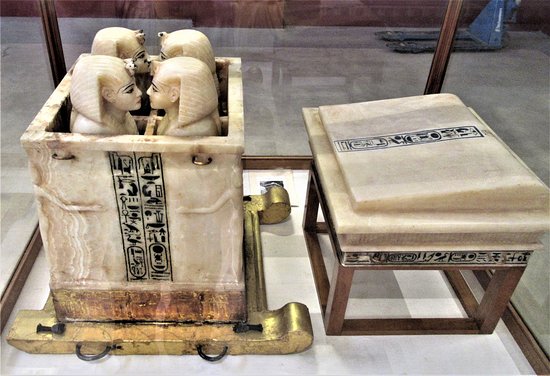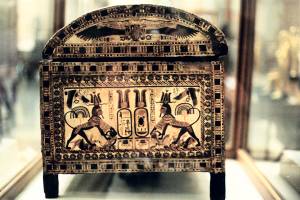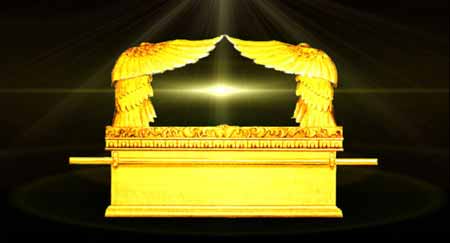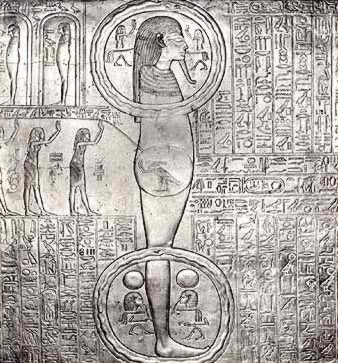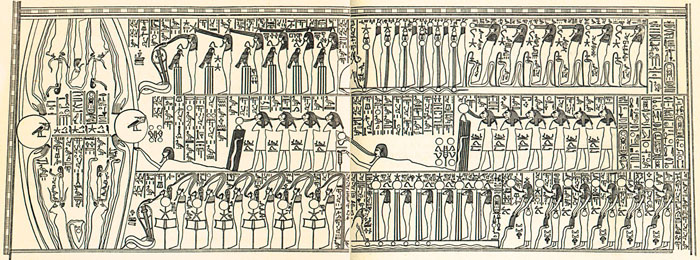rituals
part IV – treasure (clues) of Tutãnkhámen
PART IV
The core of the serpent-hand, as executive region within the upper node,
has to be ‘a complete inversion of shrines’, like the famous wooden Russian dolls nested
into oneanother, but now being nested the other way around.
There are many correlations between the themes of Tutankhamen’s shrines, and the
setup and aspects of theTabernacle in Exodus, and we are sure that the former must depict
the latter’s complete Inversion.
| the canoptic alabaster shrine Again we have the similar type shrine with curved roof, above; its roof should go atop of the shrine, so that the four Horus-sons inside get covered; |
– note the concept of ‘slide’, where the shrine stands upon;
it is intended to depict a slide, and the context of ‘slide’ must be that it is being
“dragged (into) somewhere” – not a mere ‘moving around of the shrine’;
compare, to right, the often returning glyph TEM-, ‘to complete’,
usually without shrine, but for context showing this glyph-pic; the term TEM- can read
“the shrine / at place-T / to complete”;
– the “four sons” within the shrine, all represent ‘a certain area’,
though their context is a bit slippery –
QEBH’SNEF, “he / to copy / the cooled-down q-axis (of speech)”,
MESTÁ or ÁMSTÁ as the staff-tá to birth (from halfstaff-T in lampstand),
H’EP as the eden-tile, “the hidden (square) as root-P for the saturn-wick”,
and T’UAMUTF as “he / the mother-T / (for, as) the t’ua-star”,
… so these four represent “mixed constructs”,
and sit now together within an enveloping fifth shrine, as the serpent-hand TCH-;
the columns written on all four sides of the alabaster shrine are readable,
but has a completely different style as the examples we showed, until now –
— first side of shrine (lefthandside column),
“the word of hail / (of) existence / (in name of) all (3) transformations for the light (cartouche) / (through) place-T by the Cain-soul the adamite throne to make / (as) place-T at the q-axis for speech (rqt) / (of) existence (matrix), / (for) existence of hail, / to recite; “
(lefthandside column),
” the word of hail / (of) existence / (for) tutãnkhamen (cartouche-name) / (of) Osiris (as construct), /
(by) to divinely weave (neith) / existence of hail, / to recite; “
— second side of shrine (righthandside column),
” (for) tutãnkhamen (cartouche) / (-T’s of) all / (through) he to copy the cooled-down q-axis (horus-son) / (for) the ãnkh-life / (as) the god, / by (means of) / thou / existence to become new (unn), / (through) to divinely weave (neith) / existence of hail, / to recite;”
(lefthandside column),
” all (3) transformations for the light (cartouche) / (through) place-T by the Cain-soul the adamite throne to make / (as?) the most-b-soul-adam-like place-T to birth (?) / (of) beauty (nefer), / thou / the (lost) / (speech) to transform / (and so) by / thou / existence to become new, / (through) the essence of place-T of the adamite throne (Isis) / (for) existence of hail, / to recite;”
— third side of shrine (righthandside column),
” existence / (as) existence / (by) all (3) transformations for the light (cartouche) / (through) place-T by the Cain-soul the adamite throne to make / (by) the hidden root for the saturn-wick (horus-son) / (as) thou / light / (by) the dimensional background of saturn (h’a) / (for) existence to become new, / (as) place-T of the chalice (nebth’t) / (for) existence of hail, / to recite;”
(lefthandside column),
” tutãnkhamen’s (cartouche-name) / khu spirit / (by) he the mother-T for the t’ua-star (horus-son) / (as) thou / ãnkh-life / (of) all / protection (sa), / (through) the divine place-T at the q-axis speech to make (serqt) / (for) existence of hail, / to recite;”,
— frontside (both righthandside, read towards centre),
” the true voice / (by) all (3) transformations for the light (cartouche), / (by means of) place-T by the Cain-soul the adamite throne to make / (for) the divine staff-tá to birth (horus-son) / within, / \\which is (by) / the staff-tá to birth / (of) divine protection (sa), / (by) the chisel the root to make place-T / (for) the divine within / \\which is (for) / the an-face (north) / (of) willpower (matrix) / (by) willpower (eden’s) / to veil (h’ap), / (through) the essence of place-T of the adamite throne (Isis) / (for) existence of hail, / to recite;”
(lefthandside, towards top centre),
“the word of hail / (for) tutãnkhamen (cartouche) / (by) the royal south (suten) / (as) Osiris (as construct) / within, / \\which is (by) / the divine m-b-soul-adam-like hidden root for the saturn-wick (horus-son) / (for) the an-face (north) / (of) divine protection (sa), / (by) the chisel the root to make place-T / (for) within, / \\ (by) which is / the an-face (north) / (of) willpower / (by) willpower (eden’s) / to embrace the q-axis (for the light of) existence of hail (ánq+) / (as) place-T of the chalice (nebth’t) / (for) existence of hail, / to recite;”
| – protectresses of the main shrine In the text above, each son (construct) has a protective main-goddess; H’EP is here related to Nebth’et, as the eden-tile for their new root, MESTÁ to Isis, the half-staff of lampstand now in the north as adamite throne, T’UAMUTEF by the Serget scorpion, and QEBH’SNEF to Neith,…yet one would expect that Serqet is over Qebh’senef – because of the axis theme; showing that apparently they are somewhat interchangable. The same four goddesses protect another golden shrine’s cardinal directions, picture right; where the top-row of uraei is the same theme as the balcony of the shrine in the Seti I mural, but here it shows first time the ‘interlocked shrines’, as the russian doll concept |
 |
2] the nested shrines of Tutankhamen’s tomb
| After previous pages, where the same type shrine returned as theme, yet always placed in different situations, now the concept of ‘nested shrines’ make perfect Sense! The mind does not like to think ‘dimensional’, therefore here we proceed carefully, yet remembering the Ezekiel line “… wheels within wheels”; as well as the ‘four coffins’ in amtuat IX (of which we suspected already they are ‘consciousnesses’, but we’ll need to revieuw the chapter again, related to this theme). |
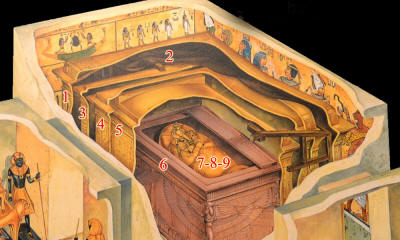 |
To [above] right, the diagram showing how the nested shrines were positioned within the tomb, factually four wooden shrines, overlayed with gold,
and one strange construction between the outer- and second shrine (marked ‘2’ in the diagram); all of these enveloping the granite coffin.
Realizing how Tutankhamen knew very much about the real situation, we must be attent for every detail in the symbology, whether it perhaps points to something we’ve seen until now – when a total of ‘nine’ coffins show here, we must make the link with “the nine area’s within the house of Saturn” (BD); yet our main concern is ‘how the eden attributes are mixed inhere’.
Briefly we go through the aspects of every shrine,
| 1] the outer shrine The first shrine Carter saw was of gold, inlayed with deepblue faience, showing rows of the Isis knot (TeT) together with the djed-pillar, both doubled; the same sigils as depicted at the base of the alabaster shrine, previously. The very pattern of gold-blue-gold must relate to the mixture of eden-gold and lapis-lazuli we saw before, where the TET- hovers over the lampstand as bizarre vagina, receiving all of the eden aspects.The roof of the shrine, to right, is different as the usual shape we saw until now; this roof resembling the mountain-glyph T’U-, glyph-pic to right; which gives us a clue: this glyph as “double camel hump” represents both the mountain North, and the eden-mountain, where Eden rules ‘their’ mountain, north; hence in Book of Gates the boat sails thróugh both humps, in order to seperate both mountains – and inverse the rule as their matrix ruling both mountains. – the outer shrine represents their rule over both mountains. “… The two doors are each adorned with a rectangular panel with sunk reliefs. The one on the left depicts a headless and pawless leonine creature, while the one on the right has a seated divinity with twin feather headdress, grasping an ankh (life) sign.” …..which confirms the above: the ‘headless lion’ is Eden’s rule, in the one half (the one mountain), while Shu is seated at the righthand side, wearing the feather-axis of doubled-rule, |

|
| 2] the tent (from same link), “Situated between the outer shrine and the first inner shrine was poorly constructed, nine-piece gabled framework of gessoed, varnished and gilded wood. Over this framework had been carelessly spread a coarsely woven, dark brown linen pall, made up of several widths of material that were sewn together. Decorating the cloth were large, 4.7 centimeter marguerites of gilded bronze which had been sewn onto the fabric at intervals of 19.5 and 22 centimeters. J. H. Breasted thought that this pall was ‘like a night sky spangled with stars.’ Regrettably, it suffered extensive damage due to its having been left out in the open during the period that the American team was locked out of the tomb and laboratory.” …. this strange tent inbetween the golden shrines makes no sense – but please remember the ‘covering textile, with figurines at regular distance painted upon it ‘, because the theme will return at the exodus tabernacle, |
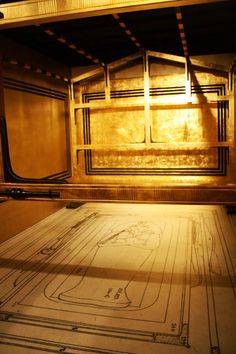
|
 |
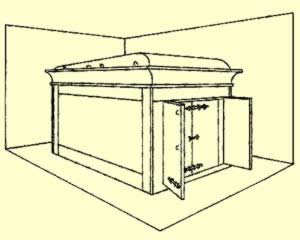 |
3] the second shrine
to right; as the same type roof we got accustomed to;
per context, this shrine should depict the ‘next step of building their matrix’, and this second shrine carries what is dubbed “the enigmatic book of the netherworld”:
containing a number of interesting themes – see further on this part III – but accompagnied by an (even for us!) bizarre written hieroglyphic text. A section of this book, pictured above, shows Osiris now ‘standing upright’, his feet within the lampstand, the Ba-spirit above the tile, and his head as Sekhet-áaru.
Like in the outer shrine, also here a number of fragments of selected BD and PT spells are inscribed, as well; but at the moment we lack the time to go compare their context toward the theme of each shrine; that Nut (torus dome) shows in this one, together with the ‘seven cows’, shows that this shrine is indeed about ‘to go construct their realm above the tile’,
 |
 |
4] the third outermost shrine,
Outwardly similar to the previous one;
the context of this shrine must be the doubled rule of the serpent-hand TCH-, as a “doubled four”,
or read, as ‘installing the concepts as the horus-sons’ of the previous alabaster shrine –
“The roof of the third outer shrine depicts a winged solar disc and a vertical row of eight spread-winged birds, including four vultures, two mythical serpent-headed vultures and two falcons. The outer faces of the doors are adorned with four ram-headed guardian figures and four heralds, each grasping one or two knives, and variously represented as human-headed, antelope-headed or crocodile-headed.”
Both Isis and Nebth’et, representing the double-rule, may support the theme of this shrine (picture above);
| 5] the fifth shrine, in spite of extensive search, we cannot get confirmation about the nature of this shrine – there aren’t any photo’s but only from a secondary small shrine – a situation which we automatically consider suspicious; the reason is the description of this roof as “barrel-vaulted” (half-cylinder), shown in the shrine picture to right, the perfume chest below it, and in the crossection diagram, above; the rounded dome being very unusual in Egypt, maximum seen in the ‘basement type tombs’ of the lower nobles, but it is a mystery why this closest golden shrine in the first place cárries this rounded-dome symbolism.Because the only rounded-dome form we know, is the Halo upon the firmament – described by Ezekiel as the “rainbow-shaped form”, which is not even present in glyphs *but* in the moon glyph, as ‘stolen light’; while the bow PETCH- is related but not in similar context. Photo above – presumably Tutankhamun and his wife depicted; |
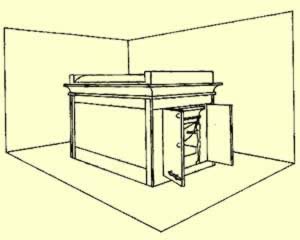
|
| 6] the granite sarcophagus the box itself hewn out of brown-red quartzite, having a lid of granite in the same sloped roof form; the lid cracked through it’s centre, and was carefully restored (to right), but we consider it was a genuine accident, instead of an intended theme referring back to the first (mountain) shrine. |
 |
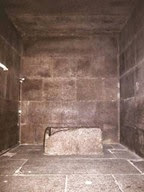 |
 |
positionings and stone, ÁNER-
where a similar granite coffer, namely the one in the Giza pyramid, is directed at the north-south axis (pic to right), having the king’s chamber [as rectangular house of saturn) at the east-west horizontal.No we do not think ‘that the ark of the covenant could perhaps fit inside the sarcophagus’, but the very fact that the similarity of “a chest with lid” in both ark and sarcophagus is too large to ignore;automatically raising questions about the real méaning of the sarcophagus and its positioning [compare diagram page, and Tabernacle section below],
| Something is going on with the ‘stones’ in the cluster, to right; note please that the translation is very staccato – but that is because we do not yet understand its context, and therefore do not know which colour to add to the meanings, yet:
the first position, at top, ‘sandstone’, |
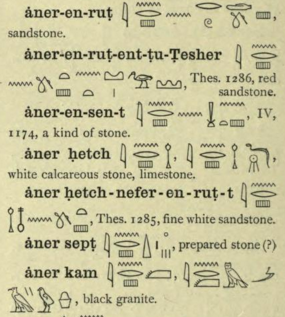 |
second position, ‘red sandstone’,
“the foreign land / eden-aether / (for?) the mountain / which is (by?) / the stone at place-T to grow /
(for) existence / (as?) the stone (of speech for existence of hail) “,
third position, ‘a kind of stone’,
“the stone (tile) at place-T to copy / (for) existence / (by,as) the stone (of speech for existence of hail) “,
fourth,
“the white light (of saturn) / (as,by) the stone (of speech for existence of hail) “,
and please remember that the Giza pyramid was once encased with a smooth top layer of bright-white sandstone, while the pyramid MER- itsélf is related to “transforming speech”, PT660;
fifth, ‘prepared stone?’,
“the lights / (of) zodiacal light (likely) / (as,by) the stone (of speech for existence of hail) “,
and last position, below, ‘black granite’,
(by,as) the stone (of speech for existence of hail) “,
… it are bizarre concepts,
we can guess the eden-tile is involved here, not like ‘literal stone’ but perhaps containing an element, sháred with their matrix, in order that the (eden-) rule “resonates through their dimension”, for great lack of better phrasing, because the tile (or ‘firmament’, as Ezekiel terms it) is “the mouth”, and hence directly related to ‘speech’. Perhaps that is exact why the MER- pyramid can defórm that speech…?
the direction of light at the cherub-wheel being inversed?
but the ‘enigmatic book of the netherworld’, engraved in the second shrine, shows a serious possibility that the cherub-wheel [which is at the tile, or, as Ezekiel described, “in the land”] is likely the circle at the figure’s tummy in the copy of the shrine, below;
touregypt
– the upright standing Osiris:
in the engraving, above, the figure of Osiris has his feet standing within the lampstand,
while his ‘head’ must be the region of Sekhet Áaru, as “the high place”;
still visible in his tummy/plexus area is a third circle, having a Ba-bird inside;
where the typical place of the Ba spirit-soul is “the place of Õn” (see diagrams);
– the double set of glyphs within the larger circle around his feet read,
“to come / the shoulder / (of) covering / (as) the essence by the mouth / (for) the light”,
where ‘the shoulder’ is related to the lampstand-arm;
implying that their false light is now illuminating “the land south” in order for them to dwell in that land now — through a false light produced fróm the ‘essence of the mouth’ (read: by the tile in the centre of the body). BD 17 we currently revise seems to tell this same thing;
…while the upper circle, around the figure’s head – as the region Sekhet Áaru reads,
“to come / the covering / (of) praise”,
as the stolen aspects to create their main fields, see the vignette of the irrigated fields full of abundance in previous section or the one of BD 110;
– the cherub’s wheel direction-of-light inverted
as we was continuing, perhaps they didn’t “elevate one wheel”, but instead “inversed the direction of it”, like light shining the opposite way through a lens; and a recent PT seems to confirm this
‘inversion’ as the glyph Sa;
and where Osiris is “the concept of the matrix standing upright”,
Horus may well be ” the rule over both sides of the eye-lens [as cherub wheel] “, read, as “directing which light goes through that lens from which side “, and considered the spells about “the red and blue eye of Horus”, and parts of the text of BD 17 (we post next); in the sense that Horus doesn’t have “twó eyes” (as we presumed! ) but more like “rules the direction of light through the sáme (one) eye”.
to the left, the same depiction of this ” inversion “, showing crystal clear how óur “reality” is totally opposite to the eden one (see main diagram); seen by the bulls below and the inversed bulls in the upper half; while the Ba spirit-souls again seem to occupy and rule the centre, shown by the same circles as the circle in the Osiris figure, above; That there are “two circles” at each side (each having a Ba-soul inside) may depict that “the Ba-souls rule the both directions of the light” (eden’s, as well as theirs);
however, the glyphs in the picture are so bizarre,
it seems so in-the-knowing like like we have computerlanguage,
and we don’t want to devise a meaning without grasping them —
please give us few days for working out the several spells to find
confirmation for this inversed light direction —

